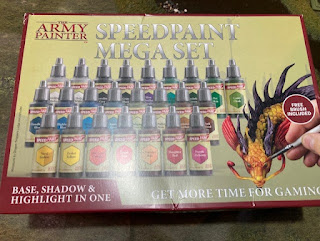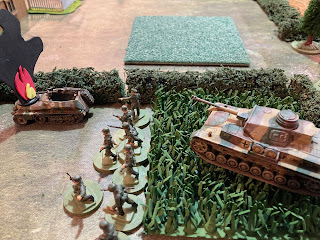Some may recall our early attempt at playing a WW2 battle using Rapid Fire rules. In those battles the Germans in defence had a couple of Panther tanks, while the US forces had four Shermans. It was a blood bath with all of the US tanks destroyed and most of the infantry downed.
For a second attempt, we decided that the German tanks would be less capable and they would be attacking. They had two Panzer IVs and two Stug IIIs, as well as two half-tracks. They also had two companies of infantry and a company of Panzer Grenadiers in the half-tracks. The US had four Sherman tanks and a battalion of infantry. Neither side had artillery, but both had mortars, machine gun teams and anti-tank weapons.
I am not going to give a full battle report, but merely a taste of how the battle unfolded. Will played the US forces and I the Germans. The battlefield was typical Normandy highly vegetated farmland, with a pair of farms, which were the German objectives:
The German plan was to sweep around the US right flank with maximum force, while keeping some forces over on the US left to fix his troops and armour there. The bulk of the German infantry, the Panzer Grenadiers and two tanks rapidly move around the flank.
Not expecting the German move, the US deploy a company of infantry, supported by a machine gun and two Shermans forward.
The German advance forces the US to pull back and the armour begins to exchange shots
The Stug III is damaged while the Germans have no luck against the Shermans.
The Panzer Grenadiers dismount and attack the US infantry in the copse
The copse is heavily defended. One of the Shermans is damaged.
The damaged Sherman continues firing and destroys one of the half-tracks and the damaged Stug, but not before the US company in the copse is badly shot up and routs. Also one of the Shermans by the farm is destroyed, but a company of Germans in the centre are caught in the open by concealed machine guns and forced back.
On the opposite flank the Germans continue to fix the US troops around the farm.
Covering fire on the US left is provided by a German machine gun, but this is forced back by US mortar fire.
The Panzer Grenadiers make it to the copse, but a combination of mortar and tank fire reduces them to being non-operational. Hand held anti-tank weapons have no effect even in the close country around the farms. The Germans push their tanks forward and it looks as though the US defence is about to collapse.
The damaged Sherman by the copse takes out the second half-track, before being destroyed by a Panzer IV
But, how fortunes can change in a wargame. The two remaining Shermans move into position and with lucky shots destroy the two Panzer IVs. With just one Stug remaining and half of their infantry destroyed the Germans called it a day - a close run thing. An exciting game. The rules worked well. Despite gaining local superiority the Germans did not have the strength to carry it through.
























